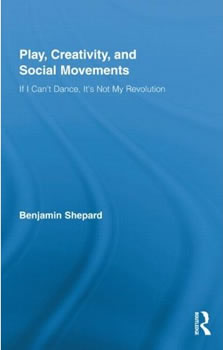 Benjamin Shepard’s book Play, Creativity, and Social Movements: If I Can’t Dance It Is Not My Revolution contributes to the burgeoning scholarship on the important relationship between play and activism. Through theoretical notions of play, interviews from the key players in social movements, and Shepard’s own lengthy career as an activist, the author analyzes the role of play in social protest. In Shepard’s fifth book, he takes the reader on a journey of the creative ways that activists have garnered attention from the public, teased law enforcement, and demonstrated more interesting designs for living.
Benjamin Shepard’s book Play, Creativity, and Social Movements: If I Can’t Dance It Is Not My Revolution contributes to the burgeoning scholarship on the important relationship between play and activism. Through theoretical notions of play, interviews from the key players in social movements, and Shepard’s own lengthy career as an activist, the author analyzes the role of play in social protest. In Shepard’s fifth book, he takes the reader on a journey of the creative ways that activists have garnered attention from the public, teased law enforcement, and demonstrated more interesting designs for living. The first two chapters of his book discuss groups that influenced contemporary social movements, Chapter One being an overview of the Dada, Surrealist and Situationist movements. In Chapter Two of the book, Shepard discusses the early social movement founded by Abbie Hoffman and other activists – the Youth International Party (Yippie). He interviews former Yippie Dana Beal. The interview is both humorous and insightful. Greeting the author at the door in his trademark “blue jeans half unzipped, no shirt, and cowboy boots” with a “Mark-Twain like handlebar mustache” (39), the reader knows they are in for a treat and certainly Shepard delivers. Shepard’s vivid descriptions and Beal’s amusing responses during the interview, provide important insights into what is often considered one of the most influential groups in terms of contemporary social movements.
The second half of the book is a lively history of more recent social movements and their strategies, including ACT UP, the Lower East Side Collective (LESC), More Gardens! and Times Up! Given that Shepard participated in these groups, his perspective, alongside the interviews he conducted, provide a thorough analysis of how play not only centered these activist groups in terms of the tactics used to garner outside attention to critical issues but also served to make the lives of the participants better. For example, in discussing ACT UP and their use of drag, Jay Blotcher, a participant, muses, “maybe because we are gay, maybe because we were staring down death, a tradition of black comedy comes into play here” (59). ACT UP balanced the need for sexual liberation and play amidst fear and death. The same can be said of LESC, More Gardens! and Times Up! but rather than use black comedy and sexual liberation to brighten the lives of participants, these groups employ clowning and street parties.
Playful tactics began to be questioned when a sense of earnestness was called for, specifically after 9/11, when these often ironic engagements were seen as mean spirited or unproductive. Shepard spends the last chapters of his book discussing how play in social movements does not necessarily always produce social change. There remain questions, for example, about how playful antics influence policy, or garner participation from the working class. The use of carnival tactics, such as clowning, may not be the best choice when dealing with certain issues. However, these forms of engagement diffuse tension with law enforcement (this can be seen in the example of the police officers’ apprehension in being heavy handed with a protestor dressed as a flower), surprise bystanders and other protestors (as seen with the clowns shouting “white powder” and throwing flour in the air while white supremacists shouted “white power”), and providing an alternative to dour, serious activism, which doesn’t necessarily garner public enthusiasm nor media attention.
Shepard concludes with the strengths and limitations of play and how play is useful to social movements. Noting that play “recognizes pleasure,” “cultivates humor,” and “makes social change work feel compelling and inviting” (263); the limitations of play such as the possibility that it can become “stale quickly” and “can be seen as just entertainment” seem to more specifically point to how play is employed within protest. Overall it appears the strengths of play in social movements heavily outweigh the negatives. Shepard argues, “while serious politics often mirrors the very power structures activists oppose, playful responses open up questions, stories and spaces” (275). Play, Creativity, and Social Movements is entertaining and inspiring. The book is a glimpse into the funny antics of the past, and the continuing possibilities of playful social protest. Shepard has spent his life as a tireless activist and prolific scholar; his fifth book offers a history of the role of play in social movements rich with all of the passion, dedication and sense of humor of those who play for social justice. Shepard’s book is a must read for those who know that “there is joy in changing the world” (33).
— Carmen L. McClish , University of the West Indies, St. Augustine


